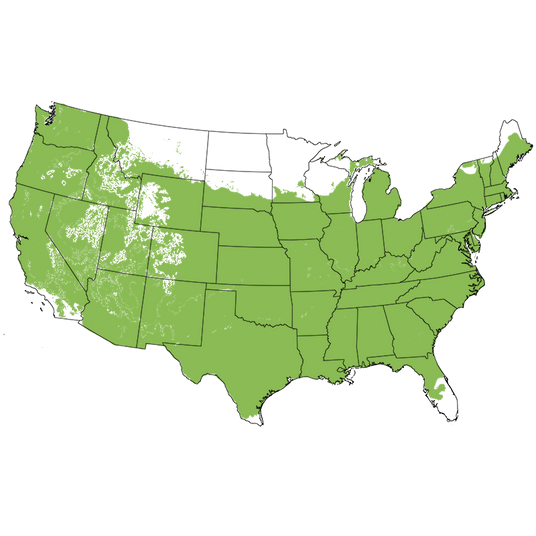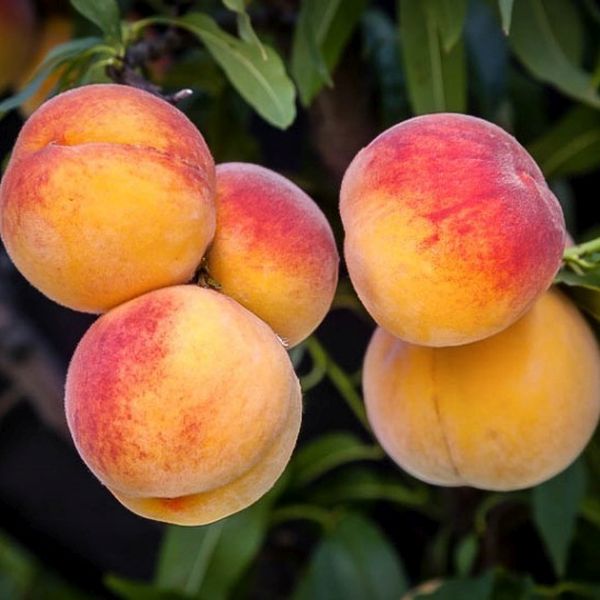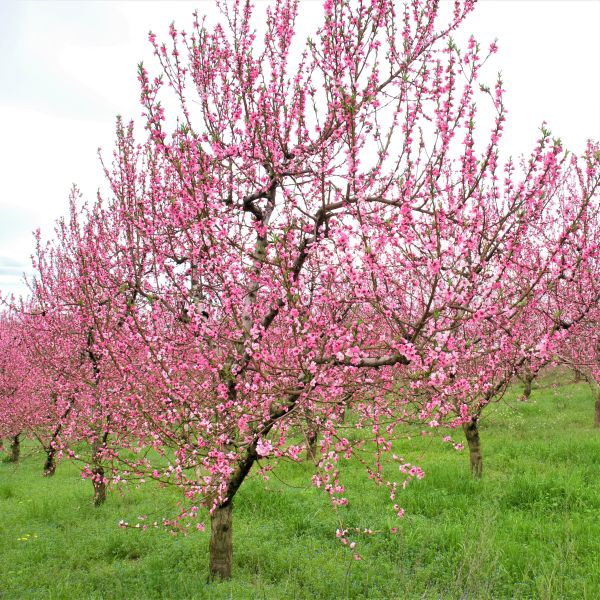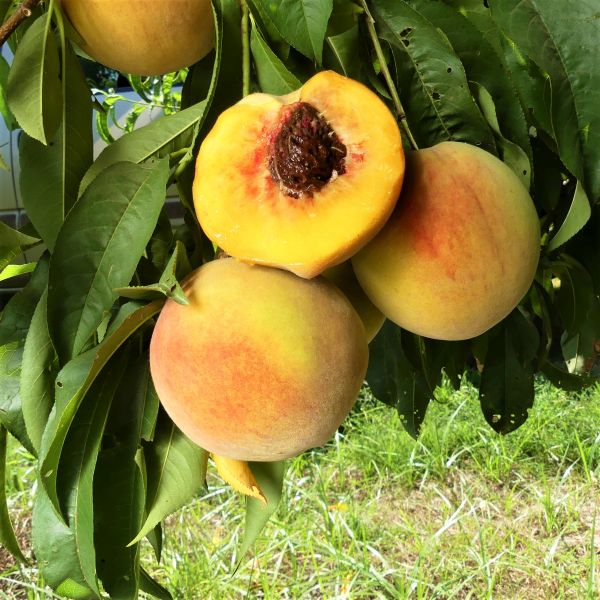Elberta Peach Tree
Prunus persica 'Elberta'
Plant Sentry™
Plant Sentry™

Plant Sentry™ Protected
Your order is protected by our compliance system that:
- Prevents restricted plants from shipping to your state
- Ensures plants meet your state's agricultural requirements
- Protects gardens from invasive pests and diseases
Delivery and Shipping
Delivery and Shipping
Delivery and Shipping
Fast, Safe Plant Delivery
Ships in 3-4 business days • Tracking provided • Weather protected
| Under $50 | $9.99 |
| $50 - $99.99 | $14.99 |
| $100 - $149.99 | $16.99 |
| $150 - $198.99 | $24.99 |
| $199+ | FREE |
✓ Zone-specific timing • ✓ Professional packaging • ✓ Health guarantee
Understanding Plant Options
Nature Hills offers plants in two main formats:
- Container Plants: Grown in pots with soil, sized by container volume and plant age
- Bare Root Plants: Dormant plants without soil, sized by height measurements
Container Plant Sizes
Container sizes indicate plant age and growing capacity rather than liquid volume equivalents. Our containers follow industry-standard nursery "trade gallon" specifications, which differ from standard liquid gallon measurements.
Young Plants (6 months to 18 months old)
| Container Size | Actual Volume | Metric Equivalent |
|---|---|---|
| 2" x 2" x 3" | 0.18 - 0.21 dry quarts | 0.20 - 0.23 dry liters |
| 4" Container | 0.31 - 0.87 dry quarts | 0.35 - 0.96 dry liters |
| 4.5" Container | 0.65 dry quarts | 0.72 dry liters |
| 6" Container | 1.4 dry quarts | 1.59 dry liters |
| 1 Quart | 1 dry quart | 1.1 dry liters |
| 5.5" Container | 1.89 dry quarts | 2.08 dry liters |
Established Plants (18 months to 2.5 years old)
| Container Size | Actual Volume | Metric Equivalent |
|---|---|---|
| 2 Quart | 2 dry quarts | 2.2 dry liters |
| #1 Container | 2.26 - 3.73 dry quarts | 2.49 - 4.11 dry liters |
| 5" x 5" x 12" | 3.5 - 4.3 dry quarts | 3.85 - 4.74 dry liters |
Mature Plants (2-4 years old)
| Container Size | Actual Volume | Metric Equivalent |
|---|---|---|
| #2 Container | 1.19 - 1.76 dry gallons | 5.24 - 7.75 dry liters |
| #3 Container | 2.15 - 2.76 dry gallons | 8.14 - 12.16 dry liters |
Large Plants (3-5 years old)
| Container Size | Actual Volume | Metric Equivalent |
|---|---|---|
| #5 Container | 2.92 - 4.62 dry gallons | 12.86 - 20.35 dry liters |
| #6 Container | 5.25 - 6.01 dry gallons | 23.12 - 26.42 dry liters |
| #7 Container | 5.98 - 6.53 dry gallons | 26.34 - 28.76 dry liters |
Bare Root Plants
Bare root plants are sold by height from the root system to the top of the plant. Plants may exceed minimum height requirements.
Common Sizes:
- Trees: 1 foot, 2 feet, 3 feet, 4 feet, 5 feet, 6 feet
- Shrubs & Perennials: 1 foot, 18 inches, 2 feet
Important Notes
Container Volume Specifications
- Trade Gallon Standard: Our containers follow industry-standard "trade gallon" specifications established by the American National Standards Institute (ANSI Z60.1) for nursery stock
- Volume Variations: Actual soil volume may vary due to plant root systems and growing medium settlement
- Age Indicators: Container size primarily indicates plant age and maturity rather than liquid volume equivalents
Growing Conditions
- Plant size can vary based on variety and growing conditions
- Container size helps indicate plant maturity and establishment level
- Larger containers generally mean more established root systems and faster landscape establishment
Seasonal Availability
- Bare root plants are available seasonally when dormant
- Container plants are available throughout the growing season
- Specific varieties may have limited availability in certain sizes
Questions?
For questions about specific plant sizes or availability, please contact our plant experts who can help you choose the right size for your landscape needs.

Plant Sentry™ Protected
Your order is protected by our compliance system that:
- Prevents restricted plants from shipping to your state
- Ensures plants meet your state's agricultural requirements
- Protects gardens from invasive pests and diseases
Plant Profile & Growing Essentials
Cold hardy, Self-pollinating, Flowering, Edible, Ornamental Berries/Fruit, Attracts pollinators, and Thornless
Specifications
Specifications
-
Botanical Name
-
Height
-
Width
-
Growing Zones
-
Sunlight
-
Growth RateModerate
-
Flower Color
-
Leaf Color
-
Pollinator FriendlyYes
-
Pollinator Required
-
Harvest Time
-
FragrantYes
-
Bloom PeriodLate Spring
Planting & Care Instructions
Planting & Care Instructions
The Most Popular Home Variety Elberta Peach Tree!
- The Classic American Yellow Peach!
- Yellow Fuzzy Skin & Bright Red Blush
- Firm Flesh & Wonderful Flavor
- Large Freestone Fruit
- Our Best-Selling Peach Tree
- Gorgeous Pink to Purple Flowers
- Handsome Green Foliges Turns Yellow in Fall!
- Fragrant & Call Pollinators
- Prune to Any Size
- Self-Fruitful
- Prolific Late-Season Harvest
- Disease & Insect Resistant
- Baking, Cooking, Canning & Freezing
- 800-900 Chill Hours
The Elberta Peach (Prunus persica 'Elberta') is the original Georgia Peach! Since its introduction in 1889, the Elberta Peach has a long history of being one of the finest peaches grown. Over the years, it's become the most planted peach variety in the United States. Today, the Elberta peach remains the most popular home garden variety available.
Elberta is one of the finest fresh eating peaches. Firm flesh and incredible flavor are the hallmarks of the Elberta peach. As well, the enormous production of this wonderful peach makes it a highly valuable tree. You'll love having continual large crops of this delicious fruit every year.
These yellow freestone peaches are wonderful choices for cooking, preserves, freezing and baking. A peach pie never tasted better than one made with Elberta peaches! This is also a great canning variety because the freestone makes prepping go faster, and the fruit is nice and firm. You'll get thick, meaty slices that can be dried or dehydrated as a fantastic snack.
Ripening in the early-late season. You'll likely harvest in September, although some areas come on a little earlier in August. Though self-fruitful, consider planting another early or late selection to extend your harvest period to 3 months.
How to Use Elberta Peach Tree In The Landscape
As pretty as it is useful, Elberta cloaks herself in drifts of pinkish-purple blooms in early spring to create a lovely ornamental display! A handsome, rounded tree at maturity, and you can of course prune to any height or shape you need for your situation.
The size when left unpruned, creates fantastic shade. Set out your lawn chair beneath the strong branches and watch the bees busily work, or watch your harvest ripen in the cooling shade.
Perfect for the home orchard and as a specimen ornamental in the front of your property, these shade your patios, walkways or garden beds as well as look pretty doing it! Not to mention the juicy harvest that awaits you in late summer!
Fall brings incredible autumn color in golden yellows! Then all winter you are treated to the fantastic branching structure. Plant this beauty outside your window to watch the colorful seasons go by and to keep an eye on your developing harvest!
#ProPlantTips For Care
Fruit trees require full sun ideally, meaning at least six hours of direct sunlight per day. Plant in USDA growing zones 5 through 9 in good draining soil. The wide adaptability of this classic peach is another fine quality. While not particular on soil type, Elberta does best in enriched, highly organic soil medium.
Water regularly to ensure a healthy tree and juicy harvest. While somewhat drought tolerant once established, it’s best to protect your investment with a regular watering schedule. Keep young trees especially well-watered and do not allow them to dry out.
The Elberta Peach can be easily maintained at any height with pruning. Plan on keeping it below 8 feet so you can easily maintain the tree while enjoying a ‘ladder-free' harvest of your crop. The self-fruitful Elberta is also a top choice for Espaliering flat to a sturdy trellis.
For best results, fertilize your tree regularly with Dr. Earth Fruit Tree Fertilizer or a good organic, slow-release fertilizer. Add Nature Hills Root Booster while planting for a life-long symbiotic relationship with the tiny feeder roots. A generous layer of mulch helps retain soil moisture as well as insulate the root system from heat and chill.
Prune also to keep an open canopy to allow sunlight and air circulation into the interior of your tree. For more pruning tips and Peach Tree Care, head over to our Garden Blog! Since birds and squirrels love these peaches as much as you will, try to maintain a smaller form to easily cover your crop with netting so they won’t make off with your entire harvest!
You’ll quickly see why Elberta Peach Tree is one of the most popular fruit trees out there! Head over to NatureHills.com right away to get your own! Give us a call today!
Peach Tree Frequently Asked Questions
How long does it take for Elberta Peach Trees to bear fruit?
Nature Hills Nursery sells fruit trees with mature root systems that are already three to four years old, so you’ll enjoy fruit sooner than you would with younger trees! Expect a young peach tree to begin fruiting by the 3rd year after you plant it.
How Fast Do Elberta Peach Trees Grow?
Be sure to plant your peach in a sunny and well-drained location. Once your Elberta (Prunus persica 'Elberta') has been established (after the first year), it can typically add 12-18 inches of new growth in a growing season. If your plants are adding less than that in a season, it may be worth your while to check the fertility level.
Where do Elberta Peach Trees Grow Best?
Peach trees grow best in well-drained, fertile soil in at least 6 hours of full sun per day or more.
Do You Need 2 Peach Trees to Produce Fruit?
All peach trees are self-fertile, however planting more than one peach tree that blooms at about the same time, boosts yields on both trees and extends your harvest time!
Harvest Times for Elberta Peach Trees
Elbertas are typically ready to harvest in August. Keep in mind exact harvest times are subject to change depending on the hardiness zones they’re being grown in.
Early-Season? Mid-Season? Late-Season? The terminology can be confusing for new peach tree growers. Weather, climate and your tree determine when it’s ripe.
When Should Elberta Peach Tree be Planted?
Bareroot peach trees can be planted in spring when they are available in your area. Container-grown peach trees can be very successfully transplanted all throughout the growing season. Check for first and last frost dates for your area with your local County Extension Office.
- Plant bareroot peach trees in the early spring.
- Plant container-grown trees anytime the ground is not frozen by digging a hole as deep as the soil line and twice as wide.
How Do I Find Elberta Peach Trees for Sale Near Me?
Make your life easier and your yard happier by shopping for peach trees at NatureHills.com online fruit tree nursery. You’ll find a massive selection of fruit trees for sale, including many lovely peach tree varieties!
Choose the right tree for your area by first finding your USDA growing zone by entering your zip code in the field above the Plant Highlights section on our product pages. Narrow down your options by plant hardiness zone, sun availability, and size requirements.
Place your order, knowing it’s backed by the Nature Hills Nursery product guarantee and protected by Plant Sentry™, which helps ensure regulated plant materials aren’t sent to prohibited areas.
Expect to receive your plants at the appropriate planting time for your growing zone when temperatures are safest for those plants that ship in fall, winter, or early spring.
Shop the selection of mature peach trees for sale at Nature Hills Nursery and place your order for Elberta Peach Tree today.
What shipping options do you offer?
NatureHills.com works closely with our growers and nursery professionals to ensure we ship when it is most appropriate for your area. Our goal is to deliver the hardiest plants by avoiding extreme high and low temperatures. Check out our shipping schedule for more information and to learn our wills and won’ts when it comes to shipping plants. Find your Elberta Peach Tree for Sale for sale here at NatureHills.com!
The First “Georgia Peach”
The Elberta Peach is at the root of Southern Peach growing, in fact it is the true Georgia Peach. Samuel H. Rumph was raised on his grandparents plantation in Marshalville, Georgia, which grew an assortment of every variety of fruit suited for the Georgia climate. From this early exposure, Rumph acquired a keen knowledge and passion for horticulture and was managing the plantation by his early teens.
In 1857, a private banker named Mr. I.C. Plant purchased a selection of Peach trees from the Delaware Nursery. These varieties included Chinese Cling, Early and Late Crawford, Old Mixon Free, Tillotson and Stump of the Earth. He shipped them to Samuel Rumph's grandfather, where they were planted in the orchard.
They all grew well, most particularly the Chinese Cling, which produced a fine quality fruit.
By 1870, Samuel had the family bug for planting and was given seeds from the Chinese Cling by his mother and grandmother. Only one of the seeds was noteworthy. It produced a fine quality, yellow freestone Peach that was immediately recognized as a superior selection.
In 1874, Samuel was married to Clara Elberta Moore. As the story goes in 1875, while entertaining a visiting college friend, Rumph was asked what the name of this exceptionally fine fruit was. Rumph told him it had no name and he invited his colleague to name it; his friend thoughtfully suggested it be named after Samuel's wife. So was born the Elberta peach!
The Elberta gained local popularity quickly and was soon being tested for market. The especially long shelf life made the Elberta ideal for shipping, and by 1880 was being shipped un-iced to New York, where it commanded high prices.
The excitement over the Elberta seedling selection from the original Chinese Cling spurred Rumph to plant more seeds on the family orchard.
Again, just one seedling would produce another exceptional selection; this being the famous Belle of Georgia Peach. As a result, the two varieties most associated with the famous "Georgia Peach" are sisters!













